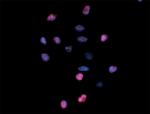- Clone
- QA18A32 (See other available formats)
- Regulatory Status
- RUO
- Other Names
- Mki67, Ki67, Ki-67, MIB-1, KIA
- Isotype
- Rat IgG1, κ
- Ave. Rating
- Submit a Review

The nuclear protein Ki-67 was first identified by the monoclonal antibody Ki-67, which was generated by immunizing mice with nuclei of the L428 Hodgkin lymphoma cell line. Ki-67 protein plays an essential role in ribosomal RNA transcription and cell proliferation. Expression of Ki-67 occurs during G1, S, G2, and M phase. While in G0 phase, the Ki-67 protein is not detectable. Ki-67 is strongly expressed in proliferating cells and has been reported as a prognostic marker in various tumors.
Product DetailsProduct Details
- Verified Reactivity
- Mouse
- Antibody Type
- Recombinant
- Host Species
- Rat
- Immunogen
- E. coli expressed, N-terminal His-Thioredoxin-tagged, partial mKi-67 (1816-2163 aa) recombinant protein.
- Formulation
- Phosphate-buffered solution, pH 7.2, containing 0.09% sodium azide
- Preparation
- The antibody was purified by affinity chromatography.
- Concentration
- 0.5 mg/mL
- Storage & Handling
- The antibody solution should be stored undiluted between 2°C and 8°C.
- Application
-
IHC-F - Quality tested
ICC - Verified - Recommended Usage
-
Each lot of this antibody is quality control tested by immunohistochemical staining on frozen tissue sections. For immunohistochemistry, a concentration range of 5.0 - 10.0 µg/mL is suggested. For immunocytochemistry, a concentration range of 1.25 - 5.0 μg/mL is recommended. It is recommended that the reagent be titrated for optimal performance for each application.
- RRID
-
AB_2904309 (BioLegend Cat. No. 163202)
Antigen Details
- Structure
- 325 kD protein containing a forkhead-associated (FHA) domain and 13 tandem repeats.
- Distribution
-
Nucleus and chromosomes
- Function
- Required for cell cycle progression and proliferation.
- Interaction
- Interacts with KIF15; binds to MKI67IP through FHA domain
- Biology Area
- Cell Biology, Cell Cycle/DNA Replication, Immunology
- Antigen References
-
- Starborg M, et al. 1996. J. Cell. Sci. 109:143.
- Byeon IJ, et al. 2005. Nat. Struct. Mol. Biol. 12:987.
- Yerushalmi R, et al. 2010. Lancet. Oncol. 11:174.
- Beltrami AP, et al. 2001. N. Engl. J. Med. 344:1750.
- Sachsenberg N, et al. 1998. J. Exp. Med. 187:1295.
- Nagy Z, et al. 1997. Acta. Neuropathol. 93:294.
- Gene ID
- 4288 View all products for this Gene ID
- UniProt
- View information about Ki-67 on UniProt.org
Related Pages & Pathways
Pages
Related FAQs
Other Formats
View All Ki-67 Reagents Request Custom Conjugation| Description | Clone | Applications |
|---|---|---|
| Purified anti-mouse Ki-67 Recombinant Antibody | QA18A32 | IHC-F,ICC |
Compare Data Across All Formats
This data display is provided for general comparisons between formats.
Your actual data may vary due to variations in samples, target cells, instruments and their settings, staining conditions, and other factors.
If you need assistance with selecting the best format contact our expert technical support team.
-
Purified anti-mouse Ki-67 Recombinant Antibody

C57BL/6 mouse frozen intestine section was fixed with 4% par... 
TE‐71 cells were fixed with 1% paraformaldehyde (PFA) for te...














Follow Us